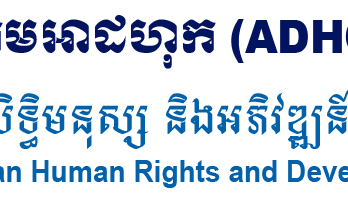EXECUTIVE SUMMARY
Victims’ participation is one of the unique features of the trials held by the Extraordinary Chambers in the Courts of Cambodia (ECCC), also known as the Khmer Rouge Tribunal (KRT). In November 2011, the ECCC Trial Chamber began its second trial, hearing evidence against three former top ranking Khmer Rouge leaders.
Nearly 4,000 victims participate as Civil Parties in this second case (Case 002), over ten times more than in the first trial. This unprecedented large number of Civil Parties in an already complex trial poses challenges for the Court, lawyers and NGOs alike to achieve a balance between the rights of victims to an effective participation and the rights of the accused to a timely trial.
Considering this challenge and the limited resources available, ADHOC, the Cambodian Human Rights and Development Association (French Acronym), has established in 2010 a Civil Party Representative (CPR) scheme, to facilitate a two-way communication process between Civil Parties, their lawyers, and the Court. ADHOC acts as the intermediary organisation for nearly half of the Civil Parties admitted in Case 002, providing assistance for their participation in the ECCC’s legal proceedings. The CPR scheme is centred on the role of 122 Civil Party Representatives who act as the focal point and link between the majority of the Civil Parties assisted by ADHOC, their lawyers, ADHOC staff, and the Court.
This study constitutes a baseline analysis for the monitoring and evaluation of the CPR scheme implemented by ADHOC. Specifically, among Civil Parties assisted by ADHOC in Case 002, it aims to examine: (1) awareness, knowledge and attitudes of the ECCC; (2) their perceptions and expectations about justice; and (3) their expectations in regards to collective and moral reparations. It is anticipated that the findings will have broader lessons-learned to inform the participation of large numbers of victims in criminal trials in international and hybrid tribunals dealing with mass atrocities.
The results are based on interviews with 120 out of 122 Civil Party Representatives (CPRs) and a random sample of 294 Civil Parties (CPs) from a remaining list of ADHOC-assisted Civil Parties in Case 002, as of May 2011. Out of the total 414 interviews, 366 were conducted in May 2011 prior the initial hearing in Case 002. The remaining interviews (48) were conducted from July to mid-November 2011, prior to the beginning of the substantive part of the Case 002 trial. Comparisons between Civil Parties’ and Civil Party representatives’ are discussed where significant differences are present and relevant to the study questions. The views of Civil Parties and Civil Party representatives assisted by ADHOC may not represent the views of all Civil Parties represented in the trials.
សេចក្តីសង្ខេបទូទៅ
ការចូលរួមរបស់ជនរងគ្រោះ គឺជាលក្ខណៈពិសេសមួយក្នុងចំណោមលក្ខណៈពិសេសនានានៃការជំនុំជម្រះក្តីនៅអង្គជំនុំជម្រះវិសាមញ្ញក្នុងតុលាការកម្ពុជា (អ.វ.ត.ក) ដែលគេស្គាល់ផងដែរជា សាលាក្តីខ្មែរក្រហម។ ក្នុងខែវិច្ឆិកា ឆ្នាំ២០១១ អង្គជំនុំជម្រះសាលាដំបូងនៃអ.វ.ត.ក បានចាប់ផ្តើមការជំនុំជម្រះក្តីលើកទីពីររបស់ខ្លួន ដោយស្តាប់ភស្តុតាងប្រឆាំងនឹងអតីតមេដឹកនាំខ្មែរក្រហមទាំងបីនាក់។
ជនរងគ្រោះជិត៤០០០នាក់ ចូលរួមជាដើមបណ្តឹងរដ្ឋប្បវេណីក្នុងសំណុំរឿងទីពីរនេះ (សំណុំរឿង០០២) គឺច្រើនជាង១០ដង បើធៀបនឹងដើមបណ្តឹងរដ្ឋប្បវេណីក្នុងសំណុំរឿងទីមួយ។ ការចូលរួមនៃដើមបណ្តឹងរដ្ឋប្បវេណីដ៏ច្រើនសន្ធឹកសន្ធាប់ មិនដែលធ្លាប់មានពីមុនបែបនេះក្នុងការជំនុំជម្រះដ៏ស្មុគស្មាញហើយនោះ គឺជាបញ្ហាប្រឈមធំៗ ចំពោះតុលាការ, មេធាវី និងអង្គការមិនមែនរដ្ឋាភិបាល ដើម្បីសម្រេចបាននូវតុល្យភាពរវាងសិទ្ធិរបស់ជនរងគ្រោះ ក្នុងការចូលរួមប្រកបដោយប្រសិទ្ធភាព និងសិទ្ធិរបស់ជនជាប់ចោទ ក្នុងការទទួលបានការជំនុំជម្រះទាន់ពេលវេលា។
ដោយពិចារណាអំពីបញ្ហាប្រឈមនេះ និងធនធានដ៏មានកម្រិត សមាគមការពារសិទ្ធិមនុស្ស និងអភិវឌ្ឍន៍នៅកម្ពុជា (ហៅកាត់ សមាគមអាដហុក) ក្នុងឆ្នាំ២០១០ បានបង្កើតជាគម្រោងតំណាងដើមបណ្តឹងរដ្ឋប្បវេណី ដើម្បីសម្របសម្រួលដំណើរការប្រាស្រ័យទាក់ទងពីរផ្លូវរវាងដើមបណ្តឹងរដ្ឋប្បវេណី មេធាវីរបស់ពួកគេ និងតុលាការ។សមាគមអាដហុកដើរតួជាអង្គការអន្តរការីសម្រាប់ជិតពាក់កណ្តាលនៃដើមបណ្តឹងរដ្ឋប្បវេណី ដែលត្រូវបានទទួលស្គាល់ក្នុងសំណុំរឿង០០២ ដោយផ្តល់ការឧបត្ថម្ភសម្រាប់ការចូលរួមរបស់ពួកគេក្នុងដំណើរការនីតិវិធីច្បាប់របស់អ.វ.ត.ក។ គម្រោង តំណាងដើមបណ្តឹងរដ្ឋប្បវេណីផ្តោតទៅលើតួនាទីរបស់ តំណាងដើមបណ្តឹងរដ្ឋប្បវេណី១២២នាក់ ដែលដើរតួជាចំណុចទំនាក់ទំនង និងចំណុចផ្សារភ្ជាប់រវាងភាគច្រើននៃដើមបណ្តឹងរដ្ឋប្បវេណី ដែលទទួលការឧបត្ថម្ភពីសមាគមអាដហុក, មេធាវីរបស់ពួកគេ, បុគ្គលិកសមាគមអាដហុក និងតុលាការ។
ការសិក្សានេះ គឺជាការវិភាគមូលដ្ឋានមួយសម្រាប់ការត្រួតពិនិត្យ និងការវាយតម្លៃអំពី គម្រោងតំណាងដើមបណ្តឹងរដ្ឋប្បវេណី ដែលអនុវត្តដោយសមាគមអាដហុក។ ជាពិសេសទៅទៀតនោះ ក្នុងចំណោមដើមបណ្តឹងរដ្ឋប្បវេណី ដែលទទួលការឧបត្ថម្ភពីសមាគមអាដហុកក្នុងសំណុំរឿង០០២ ការសិក្សានេះមានបំណងពិនិត្យអំពី៖ (១)ការយល់ដឹង, ចំណេះដឹង និងឥរិយាបទចំពោះអ.វ.ត.ក (២) ចំណាប់អារម្មណ៍ និងការរំពឹងទុកអំពីយុត្តិធម៌ និង (៣) ការរំពឹងទុករបស់ដើមបណ្តឹងរដ្ឋប្បវេណី ពាក់ព័ន្ធនឹងសំណងផ្លូវចិត្ត និងសមូហភាព។ គេប៉ាន់ប្រមាណថា គំហើញទាំងនេះនឹងមានមេរៀនដែលបានរៀនសូត្រទូលំទូលាយជាង ដើម្បីជូនដំណឹងអំពីការចូលរួមនៃចំនួនជនរងគ្រោះដ៏ច្រើនសន្ធឹកសន្ធាប់ក្នុងការជំនុំជម្រះព្រហ្មទណ្ឌ ក្នុងតុលាការអន្តរជាតិ និងតុលាការកូនកាត់ ដែលដោះស្រាយនឹងអំពើព្រៃផ្សៃទ្រង់ទ្រាយធំ។
លទ្ធផលទាំងនេះ គឺផ្អែកទៅលើបទសម្ភាសន៍ជាមួយសមាជិក១២០នាក់ ក្នុងចំណោមតំណាង ដើមបណ្តឹងរដ្ឋប្បវេណីទាំង១២២នាក់ និងប៉ាន់ជ្រើសរើសដោយព្រាវនៃ ដើមបណ្តឹងរដ្ឋប្បវេណី២៩៤នាក់ ពីបញ្ជី ដើមបណ្តឹងរដ្ឋប្បវេណីក្នុងសំណុំរឿង០០២ ដែលទទួល ការឧបត្ថម្ភពីសមាគមអាដហុក ត្រឹមខែឧសភា ឆ្នាំ២០១១។ ក្នុងចំណោមបទសម្ភាសន៍ទាំង៤១៤ យើងបានធ្វើសម្ភាសន៍ចំនួន៣៦៦ ក្នុងខែឧសភា ឆ្នាំ ២០១១ គឺមុនសវនាការបឋមក្នុងសំណុំរឿង០០២។ បទសម្ភាសន៍ផ្សេងទៀត (៤៨) ត្រូវបានធ្វើ ចាប់ពីខែកក្កដា ដល់ពាក់កណ្តាលខែវិច្ឆិកា ឆ្នាំ២០១១ គឺមុនពេលចាប់ផ្តើមនៃសវនាការលើអង្គសេចក្តីក្នុងសំណុំរឿង០០២។ ការប្រៀបធៀបរវាងចម្លើយតបរបស់ដើមបណ្តឹងរដ្ឋប្បវេណី និងចម្លើយតបរបស់តំណាងដើមបណ្តឹងរដ្ឋប្បវេណី ត្រូវបានពិភាក្សាត្រង់ចំណុចខុសគ្នា ដែលសំខាន់ៗ និងពាក់ព័ន្ធនឹងសំណួរក្នុងការសិក្សានេះ។ ទស្សនៈរបស់ដើមបណ្តឹងរដ្ឋប្បវេណី និងតំណាងដើមបណ្តឹងរដ្ឋប្បវេណី ដែលទទួលការឧបត្ថម្ភពីសមាគមអាដហុកអាចមិនតំណាងឲ្យទស្សនៈរបស់ដើមបណ្តឹងរដ្ឋប្បវេណីទាំងអស់ ដែលមានមេធាវីក្នុងការជំនុំជម្រះទេ។



